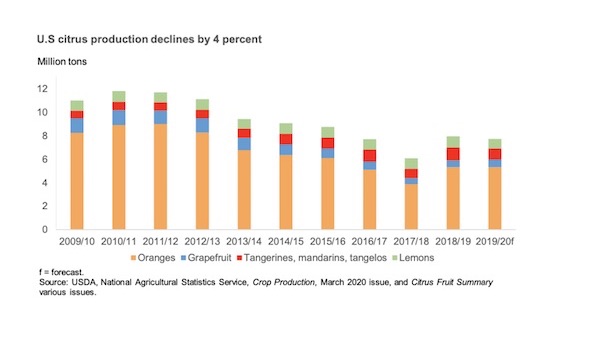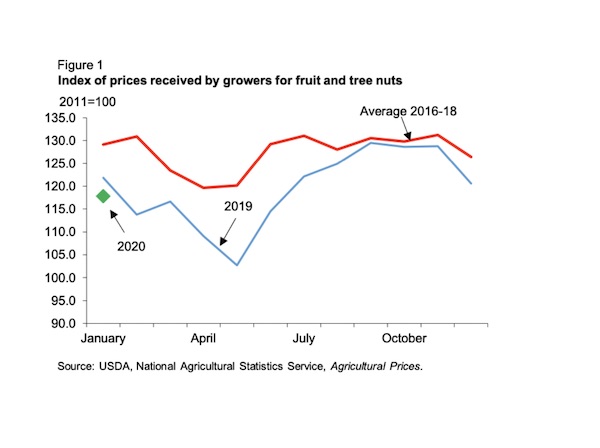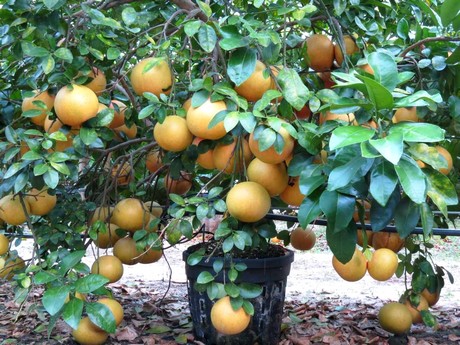- Author: Ben Faber
The USDA has released their Fruit and Nuts Outlook Report which shows the forecast the 2019/2020 seasons and provides an overview of the markets.
The 2019/20 citrus crop is forecast to be 7.63 million tons, down 4 percent from the previous season. Declines in overall production can mostly be attributed to smaller lemon, tangerine, and mandarin crops in California. Orange production in California has remained stable since last season. Citrus production in Florida has also remained stable with a 1 percent decline in orange production, and significant increases in grapefruit, tangerine, mandarin, and tangelo production over last year. Overall decreases in production of lemons, tangerines, mandarins, and tangelos are expected to result in increased imports, and higher prices compared with last year.

Fruit and tree nut grower prices began 2020 at low levels. At 117.8 (2011=100), the January 2020 index was down 10 percent from the January 2019 index and below the January average for 2016-18 (fig.1). The January 2020 index was the lowest since January 2013. Significantly lower grower prices for citrus fruit and apples drove down the index (table 1).
As of mid-March 2020, U.S. citrus exports were down except for orange juice and tangerines. Reduced exports have increased the domestic supply of citrus, putting downward pressure on prices. The January 2020 price of all- grapefruit is down 36 percent from the year before, and all-oranges and oranges for the fresh market are down by 6.9 and 9.4 percent respectively. All- lemon prices are down 28.5 percent, and fresh lemons prices are down by 8.6 percent.

Apple prices were down 21 percent in January 2020 from the year before. USDA, National Agricultural Statistics Service (NASS) estimates the 2019 total apple crop to be up 3.6 percent from 2018. The strong dollar and increased tariffs in several countries have reduced exports, putting downward pressure on prices.

- Author: Ben Faber
According to the latest USDA Foreign Agricultural Service GAIN Report (Global Agricultural Information Network), the European Union is still a major citrus producing area. EU citrus production is concentrated in the Mediterranean region. Spain and Italy represent the leading EU citrus producers, followed by Greece, Portugal, and Cyprus. For MY (October/September) 2018/19, Post expects overall citrus production to grow mainly in Spain due to favorable weather conditions. The quality of the fruit is forecast to be excellent and EU domestic consumption of citrus may stay flat in 2018/19.
EU lemon production is forecast to grow 10 percent and is stable compared with previous estimates. The overall growth is due to the strong production rise expected in Spain, the largest lemon EU producer. According to the latest data from the Spanish Ministry of Agriculture, Fisheries, and Food (MAPA), Spain's 2018/19 lemon production is forecast at 1.1 million MT, an increase of 19 percent compared to the previous year. Favorable weather conditions resulted in good flowering and fruit setting. In addition, in recent years Spain has increased its total planted area for lemons. Fruit quality is forecast to be excellent. ‘Fino' lemon is expected to increase by 14 percent due to the entry of new plantations over the last years. ‘Verna' lemon is expected to rebound; increasing by 90 percent as production of ‘Verna' lemon in the previous season was shorter than normal levels. Spain will continue to consolidate its leading commercial position in Europe with quality and phytosanitary guarantees. Following Argentina, Spain is the second largest lemon producer in the world but the first global exporter of lemons for fresh consumption. Spanish lemon production is concentrated in the regions of Murcia and Valencia, and the Provinces of Malaga and Almeria in Andalusia. ‘Fino' and ‘Verna' are the leading lemon varieties grown in Spain, accounting for 70 and 30 percent of the total production, respectively. The ‘Fino' variety is predominantly used for processing.
So far, Asian Citrus Psyllid and HLB are not a problem in the lemon producing areas of Spain and Italy. Read more about the citrus industry in the European Union – oranges, grapefruit, mandarins, fresh, processed, policy, export issues, MRLs and tariffs. Fascinating stuff and the potential impacts it has on California growers and production.
And what about what's going on in the Moroccan citrus world, right next door to Spain?

- Author: Ben Faber
One of the major challenges facing citrus integrated pest management (IPM) in California is the recent, sharp increase in the acreage of mandarins being planted. The current citrus IPM guidelines have been established from years of experiments and experience in oranges, with no specific guidelines for mandarins. In the absence of research into key arthropod pest effects in mandarins, the assumption that the pest management practices for oranges appropriately transfer for optimal production in mandarins has not been tested. We used a data mining or ‘ecoinformatics' approach in which we compiled and analyzed production records collected by growers and pest control advisors to gain an overview of direct pest densities and their relationships with fruit damage for 202 commercial groves, each surveyed for 1–10 yr in the main production region of California. Pest densities were different among four commonly grown species of citrus marketed as mandarins (Citrus reticulata, C. clementina, C. unshiu, and C. tangelo) compared with the standard Citrus sinensis sweet oranges, for fork-tailed bush katydids (Scudderia furcata Brunner von Wattenwyl [Orthoptera: Tettigoniidae]), and citrus thrips (Scirtothrips citri Moulton [Thysanoptera: Thripidae]). Citrus reticulata had notably low levels of fruit damage, suggesting they have natural resistance to direct pests, especially fork-tailed bush katydids. These results suggest that mandarin-specific research and recommendations would improve citrus IPM. More broadly, this is an example of how an ecoinformatics approach can serve as a complement to traditional experimental methods to raise new and unexpected hypotheses that expand our understanding of agricultural systems.
Read on:

- Author: Ben Faber
Growers of one of Florida's signature citrus crops, the grapefruit, may see more production and possibly less of the deadly citrus greening disease. Researchers have worked for four years, growing grapefruit under protective screens on a 1-acre experimental plot of trees at the University of Florida Institute of Food and Agricultural Sciences, and they're seeing encouraging results.
UF/IFAS scientists and a few commercial growers have used the system, known as “CUPS,” or “Citrus Under Protective Screens,” for a few years. They're trying to keep the dangerous Asian citrus psyllid away from citrus trees. Infected psyllids can transmit the deadly greening disease to citrus. So far, so good. They're noticing higher grapefruit yields and no psyllids or greening.
Florida grapefruit production has been drastically reduced by citrus greening, also known as Huanglongbing (HLB). In Florida, grapefruit production has gone down from 40.8 million boxes in 2003-2004 to 4.9 million boxes in 2018-2019, according to the USDA.
Arnold Schumann, a UF/IFAS soil and water sciences professor, leads the “CUPS” experiment at the UF/IFAS Citrus Research and Education Center in Lake Alfred, Florida.
And right now, he sees reason for optimism. Schumann is studying how well grapefruit grows in the 1.3-acre facility at the CREC.
Four years of data show grapefruit that exhibit no signs of greening, Schumann said. Researchers planted ‘Ray Ruby' grapefruit trees in August 2014. By December 2018, the trees had produced 2,100 boxes of grapefruits per acre, Schumann said. That's 525 boxes per acre per year on average, but Schumann notes that trees are less productive in the initial two years after planting. In years 3 and 4, the CUPS grapefruit yields were 797 and 892 boxes per acre, respectively. Currently the average yield for Florida grapefruit is about 166 boxes per acre per year, according to the USDA.
“HLB reduces profits for fresh citrus producers in many ways,” Schumann said “Production costs are higher due to increased needs to use pesticides and fertilizers, and fruit production is harmed by stunted tree growth, reduced fruit set and pre-harvest fruit drop, among other factors.”

The CUPS experiment at the Citrus REC has demonstrated that nearly all those harmful effects of HLB can be addressed, Schumann said.
“During the past five years, we have learned much about optimizing horticultural practices and pest and disease management for red grapefruit grown in CUPS,” he said.
Scientists focus on producing high yields with premium grades for the fresh fruit market.
“Our understanding of fresh fruit quality has been honed by our partnership with the Dundee Citrus Growers Association, which harvested and shipped our CUPS grapefruits and tangerines for the past two seasons,” Schumann said “Most importantly, fruit grown in CUPS should all be ready to sell, and our grapefruit and tangerine harvests have achieved 100 percent pack-out. For grapefruits, the fruit size is very important because it greatly affects the selling price.”
One reason for the good yield is the grapefruit's ability to adapt to the higher daytime temperatures under the protective covers, he said.
Other reasons for the increased productions include:
- High-density planting.
- A hydroponic system with trees growing in pots, instead of soil and inducing early, large blooms.
- Drip fertigation – a combination of fertilizer and irrigation -- applied several times a day.
CUPS hydroponic grapefruit has all the important attributes for fresh fruit production: high yields of HLB-free fruit, large fruit size, consistent yields and early maturity, Schumann said.
“The experiments at the CREC focused on proving that the CUPS concept was viable,” Schumann said. “Trees were grown mostly in containers, using hydroponics and very high-planting densities.
A couple of Florida growers are using the CUPS method for grapefruit, although it's too soon to know their results, Schumann said.
Scientists are not yet recommending the intensive production system used at the CREC experiment for commercial CUPS, although one grower in Hardee County is already experimenting with hydroponics and container-grown grapefruits, tangerines and navels under cover, Schumann said.
“Our aim is to maximize fruit production and quality in commercial CUPS with trees grown in the ground at moderately high-planting densities,” he said. “We want to document the most successful methods in a CUPS production guide and to update it as we learn more.”
For more information:
Brad Buck
University of Florida
Ph: +1 (352) 294-3303
bradbuck@ufl.edu
www.ifas.ufl.edu
Photo: Honey Murcott mandarin trees grow in 7-gallon pots at 1,361 trees per acre in the Citrus Research and Education Center screen house. Photo credit: Schumann, 2017

- Author: Ben Faber
It has been a struggle to get through these hot times and now it's getting cooler, it's even rained, and suddenly that beautiful citrus that has just broken color and is an orange globe splits. It's most common in navels, but all citrus that ripen in the fall – tight-skinned satsuma mandarins, early clementines, tangelos and blood oranges. With the hot summer, it seems that a lot of citrus fruit have accelerated their maturity and are ready, ripe and sweet right now, and maybe ready to split.
And that's the problem. Drought stress. Salt stress due to drought. Water stress due to miserly watering. A heat wave in July. And a weird fall with maybe rain and maybe no rain and is ¼ inch considered rain or just a dedusting? Irregular watering is the key to splitting this time of year. The sugar builds, the pressure to suck in water builds and the fruit has been held back by a constrained water pattern and suddenly some water comes and it goes straight to the fruit and Boom, it splits.
Years of drought, and a stressed tree are a perfect set up for a citrus splitting in fall varieties like navel and satsuma. The days have turned cooler and there's less sense on the part of the irrigator to give the tree water and suddenly out of nowhere, there is rain. That wonderful stuff comes down and all seems right with the world, but then you notice that the mandarin fruit are splitting. Rats? Nope, a dehydrated fruit that has taken on more water than its skin can take in and the fruit splits. This is called an abiotic disorder or disease. However, it's not really a disease, but a problem brought on by environmental conditions. Or poor watering practices.
Fruit that is not yet ripe, like ‘Valencias' and later maturing mandarins are fine because they haven't developed the sugar content and have a firmer skin. They then develop during the rainy season when soil moisture is more regular. Or used to be more regular. With dry, warm winters this may become more or a problem in these later varieties, as well.
Several factors contribute to fruit splitting. Studies indicate that changes in weather, including temperature, relative humidity and wind may exaggerate splitting. The amount of water in the tree changes due to the weather condition, which causes the fruit to shrink. Then with rewetting, the fruit swells and bursts. In the navel orange, it usually occurs at the weakest spot, which is the navel. In other fruit, like blood orange, it can occur as a side split, as seen in the photo below.
Proper irrigation and other cultural practices can help reduce fruit spitting. Maintaining adequate but not excessive soil moisture is very important. A large area of soil around a tree should be watered since roots normally grow somewhat beyond the edge of the canopy. Wet the soil to a depth of at least 2 feet, then allow it to become somewhat dry in the top few inches before irrigating again. Applying a layer of coarse organic mulch under the canopy beginning at least a foot from the trunk can help moderate soil moisture and soil temperature variation.
Once split, the fruit is not going to recover. It's best to get it off the tree so that it doesn't rot and encourage rodents.






